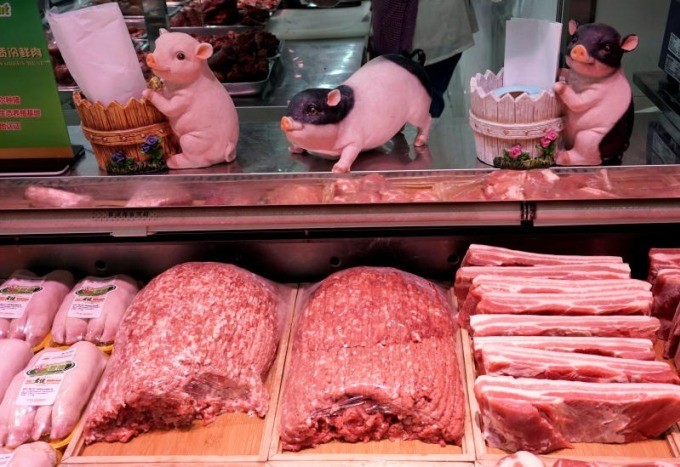 |
| Domestic pig prices have not stopped falling, but Chinese people are not loosening their purse strings. In the photo, pork is sold at a supermarket in Beijing, China. (Source: Reuters) |
Pig price today 9/29
* Pig price in the North decreased by 1,000-2,000 VND/kg.
Of which, Yen Bai and Lao Cai provinces respectively reduced 1,000 VND/kg and 2,000 VND/kg to the same level of 54,000 VND/kg.
After decreasing by 1,000-2,000 VND/kg, live pigs in localities including Nam Dinh , Phu Tho, Ha Nam and Ninh Binh were traded at 55,000 VND/kg.
Traders in localities including Bac Giang, Hung Yen, Thai Nguyen and Thai Binh all reduced the price to 56,000 VND/kg.
Today's live pig price in the North is around 54,000-56,000 VND/kg.
* Pig prices in the Central and Central Highlands regions have decreased sporadically.
Specifically, Thanh Hoa and Nghe An provinces both reduced 2,000 VND/kg to 54,000 VND/kg.
Meanwhile, live pigs in Ha Tinh were traded at VND55,000/kg, down VND1,000/kg. The remaining localities did not record any new fluctuations.
Currently, the purchase price of live pigs in the Central and Central Highlands regions is around 54,000-57,000 VND/kg.
* The price of live pigs in the Southern region decreased by the highest 2,000 VND/kg.
Of which, Ben Tre purchased live pigs at 53,000 VND/kg after a decrease of 1,000 VND/kg - equal to Bac Lieu and Soc Trang after a decrease of 2,000 VND/kg.
After a decrease of VND2,000/kg, Kien Giang province traded at VND54,000/kg. VND56,000/kg was the transaction price recorded in Ca Mau, a decrease of VND2,000/kg.
The price of live pigs in the Southern region today is around 53,000-56,000 VND/kg.
* According to Bloomberg , the autumn holidays in China are usually a boom time for pork consumption, when parties and cooler weather make many households increase their purchases of this meat. However, things seem to be changing.
The Mid-Autumn Festival (which falls on September 29 this year) is typically a time for friends and family to gather and enjoy dishes like braised pork belly or sweet and sour ribs. This year, the Mid-Autumn Festival is followed shortly by China’s week-long National Day holiday, which typically increases demand for the expensive, meaty dishes that are popular with the Chinese.
But pork consumption in the country is falling amid ample supplies, largely due to a weakening economy and financial turmoil that has affected all of China’s commodity markets to some degree.
Pork prices, which usually rise in anticipation of buyers stretching their wallets, have fallen.
“Pork sales are very bleak,” said Yao Shangli, a Shanghai-based wholesaler that supplies pork to restaurants in the city.
.
Source




















































![[Maritime News] More than 80% of global container shipping capacity is in the hands of MSC and major shipping alliances](https://vphoto.vietnam.vn/thumb/402x226/vietnam/resource/IMAGE/2025/7/16/6b4d586c984b4cbf8c5680352b9eaeb0)













































Comment (0)